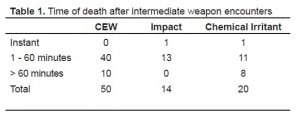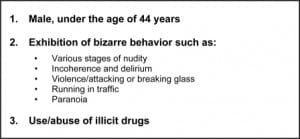| Author | Affiliation |
|---|---|
| Jeffrey D. Ho, MD | Hennepin County Medical Center, Department of Emergency Medicine, Minneapolis, MN |
| William G. Heegaard, MD, MPH | Hennepin County Medical Center, Department of Emergency Medicine, Minneapolis, MN |
| Donald M. Dawes, MD | Lompoc Valley Medical Center, Lompoc, CA |
| Sridhar Natarajan, MD, MS | Forensic Pathology and Medicine Consultant, Biodynamic Research Corporation, San Antonio, TX |
| Robert F. Reardon, MD | Hennepin County Medical Center, Department of Emergency Medicine, Minneapolis, MN |
| James R. Miner, MD | Hennepin County Medical Center, Department of Emergency Medicine, Minneapolis, MN |
ABSTRACT
Introduction:
Sudden, unexpected arrest-related death (ARD) has been associated with drug abuse, extreme delirium or certain police practices. There is insufficient surveillance and causation data available. We report 12 months of surveillance data using a novel data collection methodology.
Methods:
We used an open-source, prospective method to collect 12 consecutive months of data, including demographics, behavior, illicit substance use, control methods used, and time of collapse after law enforcement contact. Descriptive analysis and chi-square testing were applied.
Results:
There were 162 ARD events reported that met inclusion criteria. The majority were male with mean age 36 years, and involved bizarre, agitated behavior and reports of drug abuse just prior to death. Law enforcement control techniques included none (14%); empty-hand techniques (69%); intermediate weapons such as TASER® device, impact weapon or chemical irritant spray (52%); and deadly force (12%). Time from contact to subject collapse included instantaneous (13%), within the first hour (53%) and 1–48 hours (35%). Significant collapse time associations occurred with the use of certain intermediate weapons.
Conclusion:
This surveillance report can be a foundation for discussing ARD. These data support the premise that ARDs primarily occur in persons with a certain demographic and behavior profile that includes middle-aged males exhibiting agitated, bizarre behavior generally following illicit drug abuse. Collapse time associations were demonstrated with the use of TASER devices and impact weapons. We recommend further study in this area to validate our data collection method and findings.
INTRODUCTION
Death while in police custody is controversial. Specifically, a sudden and unexpected arrest-related death (ARD) occurring shortly after law-enforcement contact provokes speculation about the cause of death, such as by underlying health factors, law enforcement brutality, dangerous use of force practices, and illicit drug interaction. When an ARD occurs, polarizing reactions occur by law enforcement, the lay public, and the medical community. These groups may postulate competing explanations for the ARD. Most often, the truth remains elusive.
A large component of this problem is the lack of an accurate, uniform database to track this phenomenon. The only database currently available is the Bureau of Justice Statistic Report on Arrest Related Deaths.1 This is comprised of deaths reported by law enforcement agencies, medical examiners, and related agencies such as correctional authorities. The data are derived from a questionnaire completed by the individual reporting the event and include all deaths that occur during custody, including homicide, suicide and accidental death. This report is an incomplete measure of ARDs primarily due to lack of reporting compliance and the inclusion of all types of death that occurred in custody. Our project primarily examines deaths other than homicide or suicide, namely sudden, unexpected death during custodial arrest from no readily apparent cause.
Although literature on the topic of ARDs exists,2,3 reliable prevalence data do not. Unlike trauma registries or acute myocardial infarction databases, which are maintained as part of national healthcare statistics in the U.S. and available as public information, no collection of current, reliable ARD information is available. In an attempt to improve ARD data, we used a unique method to collect ARD data over 12 months.
METHODS
We used a prospective, web-based, open-source research method. A web-based media search service (www.webclipping.com) was used to scan national media sources daily for intended search terms. This service reports scanning coverage of 20,000 online news sources, 63,000 Usenet news groups, 90 live-streaming newswires and 1.5 billion web pages each day. The following search terms were used and tried individually and in combinations: “excited delirium; metabolic acidosis; delirium; prehospital death; paramedic death; ambulance death; police; sheriff; custody; dies; death” (factorial calculation n!=39,916,800). The gathered data were electronically forwarded daily and filtered for this project. The authors evaluated each data entry to ensure that duplicate findings were only counted as a single event. Disagreement in the data was reviewed by the lead author for conflicting or confirmatory information. Duplicate events were only counted once, and if it could not be determined as a duplicate event it was not counted. An estimated 800 reports were filtered by the investigator to arrive at the final ARD count. This filtering process occurred after the reports had been filtered by the data search service based on keywords. Qualifying cases were then entered into a spreadsheet for further analysis (Excel, Microsoft Corporation, Redmond, WA).
Data points included: location, age, gender, duration of time between first officer contact and collapse (defined as the moment the subject was noted to become unresponsive), type(s) of force used (different types were counted individually), subject behavior prior to collapse and whether or not an illicit stimulant (e.g., cocaine or methamphetamine) was used just prior to the event (defined as reported use by any data source within 12 hours prior to death). Racial data was not reliably reported and was, therefore, not collected. An event was classified as an ARD only if time of the subject’s death occurred within 48 hours of first officer contact and was unexpected. We used an arbitrary cut-off time of 48 hours to exclude deaths occurring in correctional facilities not related to the arrest control process. Homicide, suicide, and deaths due to incidents clearly leading to the death were excluded (e.g., a subject attacking an officer with a knife, which resulted in the officer fatally injuring the subject with his firearm).
Unusual behavior that was included was defined as that which would be considered out of the ordinary to a layperson given the situation. Examples included: degrees of public nudity, incoherent speech, running in traffic, breaking of glass, attacking oncoming cars or other inanimate objects, attacking people in a non-purposeful manner, and extreme paranoia. Exposure to an illicit substance was defined as intentional use/abuse, or oral or rectal concealment from law enforcement. Ethyl alcohol ingestion or intoxication was not included, as this behavior was not readily reported in the data search service.
After initial inclusion of the event based on search service data, an attempt was made to obtain both the law enforcement arrest record and any autopsy records under the Freedom of Information Act. This information was sought to gain further information on the circumstances surrounding the death, the behavior of the deceased prior to death, and whether or not an illicit stimulant substance was involved. In many of the cases, these records were not provided because of pending litigation or investigation. In cases where we could not determine these factors, they were not included in the final tally of the data.
Descriptive statistics and chi-square testing were used to evaluate subject collapse times when intermediate weapons were used (intermediate weapons are those devices that generally can induce subject compliance due to pain or incapacitation and are a level above empty-hand control techniques but less than deadly force. Examples of intermediate weapons include devices such as aerosolized chemical irritants, impact batons, and projectile beanbags).
The definitions of the types of force used were as follow. None: No physical force was used at all, but law enforcement personnel were present and had legally informed the subject that they were in custody at the time of collapse. Empty-hand control techniquesincluded a range of manually applied pain compliance techniques, wrist and arm locks, punches, kicks and strikes, as well as grappling or wrestling. This did not include the officer simply touching the person or providing manual guidance not involving pain for compliance. Intermediate weapons: chemical irritants (e.g. “tear gas” or pepper spray), impact weapons (e.g. fired baton or beanbag projectiles, flashlights, batons), and any conducted electrical weapon (CEW) such as a TASER® device (TASER International, Inc., Scottsdale, AZ). Deadly force: the discharge of any firearm or the use of any object in a manner intended to cause death.
Because the intent of this project was to present a comprehensive database inclusive of unexplained ARD events, we sought to correlate our data with two recognized organizations attempting to track ARD events. Both Amnesty International (AI) and the American Civil Liberties Union (ACLU) have posted statistics related to ARD events.4,5 We were unable to determine the methodology used by these organizations to determine the number and cause of ARD events.
This project was registered as exempt by the Hennepin County Medical Center institutional review.
RESULTS
Over a 12-month period (May, 2004–April, 2005), 162 ARD events were reported in the United States that met inclusion criteria (Figure 1). An autopsy report or an arrest report was obtained in approximately 50% of cases. There were six females (3.7%) and 156 males (96.3%) with a mean age of 35.7 years (SD±9.8, range 15–75) (Figure 2). Of these, 102 (62.9%) exhibited unusual behavior and 101 (62.3%) had exposure to an illicit substance just prior to their encounter with law enforcement.


We encountered four categories of force used by law enforcement during encounters with ARD subjects prior to their collapse. These were: none, used in 22 (13.6%) subjects, empty-hand control techniques in 111 (68.5%), intermediate weapons in 84 (51.8%), and deadly force in 19 (11.7%).
In the intermediate weapon category, we collected data on the individual weapon used. Chemical irritants were used 20 times (12.3% of all ARDs and 23.8% of all intermediate weapons), impact weapons 14 times (8.6%, 16.7%), and CEWs 50 times (30.1%, 59.5%). Chi-square analysis of this data revealed two significant associations (Table 1). First, when an impact weapon was used, it was highly associated with death occurring within the first 60 minutes of the encounter (13/14, p=0.019). Second, whenever a CEW was deployed, death did not occur instantaneously (0/50, p=0.001). Handcuff application was the only force factor recorded which had a 100% association (162/162) with ARD events. (Handcuffs are an expected end point after a significant use of force by law enforcement officers. They are used to control the hands of a potentially dangerous suspect and to place the suspect at a mechanical disadvantage for further resistance or escape). All other chi square analyses of collapse times and weapons used were not statistically significant.

Other factors frequently associated with an unexplained ARD event are male gender, age less than 44 years, history of illegal substance use, and exhibiting bizarre or out-of-control behavior (Figure 3).

DISCUSSION
There has been public concern that some less-than-lethal methods of force by law enforcement have contributed or caused ARD events.6–8 Countering that is evidence from the medical community that underlying health conditions or intoxications play a significant role. 9–19 Because of the high-profile nature and frequent litigation of any ARD, law enforcement administration and personnel must continually justify their actions and role. Research on ARD is surprisingly sparse and the phenomenon is poorly understood.
Much of the misunderstanding stems from the lack of a reliable, comprehensive, publicly available database to track these deaths. There is a federal legislative mandate (DICRA 2000, also called the Death In Custody Reporting Act of 2000)20 that requires law enforcement agencies to report to a federal repository but, to date, compliance is incomplete and data are unavailable on their website.21 The latest report shows 42 states have reported data beyond 2003.22 The DICRA database also does not currently enforce reporting despite its legislative mandate. Additionally, this database catalogues all deaths within the justice system including suicides and expected deaths during long-term incarceration, so it is not well-suited to study sudden ARD occurring during custodial arrest. Finally, this database is intended to collect ARD information from chief law enforcement officers (CLEO) rather than medical authorities. The CLEO may not report an accurate cause of death, as these data may be filed prior to official medical findings or autopsy report. All of the above factors significantly limit the reliability, validity, and usefulness of the DICRA database.
We were unable to assign causation to any single factor using the ARD data reported, and so merely report associations. We could determine factors proximal to the ARD and the incidence in which force options were applied. We believe the universal handcuff use and common use of empty-hand control techniques represent a measure of the deceased subjects’ agitated behavior (requiring the use of control techniques and restraints by law enforcement in response to their actions). Additionally, it is generally a universal policy of U.S. law enforcement agencies to handcuff subjects once they have been placed under custodial arrest (regardless of whether deadly or other force has been applied). Since being under arrest was required for inclusion in the study, universal application of handcuffs is expected.
This study is focused on a very narrow subgroup of persons who die while undergoing arrest. Of the 21 subjects who died instantly, 19 died due to law enforcement use of deadly force. The remaining two had remarkably similar histories. They exhibited bizarre, out-of-control behavior (one running naked in traffic attacking cars and the other attacking the exterior of his home with an ax), and, upon law enforcement arrival, the officers ordered the subjects to stop what they were doing because they were under arrest. In both cases, the subjects then charged toward the officers and collapsed prior to reaching the officers, and no force at all was used on the subjects. In the 19 other cases the officers used deadly force primarily because the subject attacked the officers with a potentially deadly weapon after they had been informed of their arrest. We did not find any cases in which a TASER device had been used on a suspect with immediate temporal relation to their time of collapse.
As alcohol use by subjects of ARD was not reliably reported, we did not analyze these partial data. The initial media reports that the search service forwarded to us did not reliably include these data. However, when we reviewed police and autopsy reports on the cases where it was necessary to verify other information, the majority (over 50%) of these reports indicated some degree of alcohol use. However, because we did not review every police or autopsy report, this factor was unable to be reliably recorded.
Previous research concerning ARD events has focused on single causes of death, such as drug intoxication or positional asphyxia.16,23 It is unlikely that there is a single unifying etiology. Farnham and Kennedy24 describe the importance of recognizing in our society that people tend to look for singular, proximate causes to adverse events and often confuse an action most proximate to the time of a death to be the cause of death. This post hoc fallacy can cause other more remote or contributing factors such as medical conditions or drug abuse to be disregarded. It is possible that ARDs result from a cascade of pre-disposing factors (including lifestyle choices, preexisting medical conditions, or profound delirium, leading to significant metabolic acidosis).13,16,17,25
The DICRA 2000 database is far from being accurate or complete, as explained above. In this report, we sought to overcome some of these weaknesses. Using an internet search service has been described as an “open source” research technique. This term infers a source of information open to the public. This technique has been used more often in projects related to computer or social science and not often in medicine.26 This report is a case series identified using this method of data gathering. A limitation of open-source data gathering, however, is that the data are only as accurate as the search terms utilized and as inclusive as the search service itself. We did not attempt to validate our search findings against other available search services, as should be done in future studies.
We believe that this report demonstrates a preliminary baseline of unexplained ARDs for the U.S. Because there is no national repository for ARD data and no motivation for agencies to publicly report, comparisons between agencies are impossible. Single law enforcement or healthcare agencies cannot determine whether there is a trend of ARDs or rather if they are random occurrences. This lack of baseline data makes it difficult to conclude how and why ARD occurs and whether it is preventable. This report allows interested parties to begin to communicate about ARD prevalence.
We recommend enforcement of the federal mandate of DICRA reporting, with the goal of developing an accurate, more comprehensive database to track ARD events as we would for any other cause of death. Furthermore, this database should be publicly accessible to promote open discussion that may contribute to prevention.
LIMITATIONS
Because we used web data from media headlines, our data is less accurate than medical records or coroner reports. Since there are several thousand legal jurisdictions in the U.S., contact with each county official, hospital, or medical examiner was impractical.
Our study relied upon publicly released media, medical examiner and law enforcement reports. It is possible that ARDs occurred that were never reported publicly and, therefore, not included in our data. Furthermore, each report was unique and may not have contained all the data of other ARD reports.
Our report of bizarre behavior and illicit substance use was based on notations of these factors in any one of our three sources of data (media report, law enforcement report, autopsy report). If it was not reported in any of these sources, or we were unable to obtain a needed source due to pending litigation, we did not include it for tabulation. This likely has lead to under-reporting of these factors and therefore strengthens the association between these risks and ARD.
We may have missed cases of ARD because the data were limited by our search terms and search combinations. We believe that our media search was comprehensive and utilized all (11) appropriate singular and combination search terms.
Our search yielded many ARDs that were excluded from this study. For instance, the search term, “in-custody death” yielded many instances of prisoners who died while in long-term incarceration from expected or unexpected means (advanced age, advanced cancer conditions, suicide, etc.). Since we limited our data to subjects that died in the first 48 hours, we may have missed cases where the subject collapsed shortly after arrest, was resuscitated but died days later. The author’s anecdotal opinion is that this scenario is fairly common and therefore, this study likely underestimated the number of ARD events in this nation annually.
While we acknowledge the limitations in our foundational database and methodology, it provides a reasonable baseline to begin further research into this important interface between medicine, forensics and law.
CONCLUSION
This study demonstrates factors associated with persons at risk for ARD events, including male gender, age <44 years, illicit drug intoxication, and agitation or confusion at the time of custodial arrest. Law enforcement and emergency medical service agencies, correctional and psychiatric treatment centers, emergency departments, government officials and medical examiners should consider these risk factors when faced with a potential subject, patient or ARD.
We believe that there is an acute need for a reliable, comprehensive, national data collection to validate our preliminary work. Without this, analysis and subsequent preventive measures seem impossible.
Footnotes
The authors would like to thank Mr. Mark Johnson, Ms. Bonnie O’Malley and Mr. Andrew Hinz for their diligent help with data collection. This project would not have been possible without their assistance.
Supervising Section Editor: Harrison Alter, MD, MS
Submission history: Submitted December 11, 2007; Revision Received August 07, 2008; Accepted November 28, 2008.
Full text available through open access at http://escholarship.org/uc/uciem_westjem
Address for correspondence: Jeffrey D. Ho, MD, Department of Emergency Medicine, Hennepin County Medical Center, 701 Park Avenue South, Minneapolis, MN 55415
Email: Hoxxx010@umn.edu.
Conflicts of Interest: By the WestJEM article submission agreement, all authors are required to disclose all affiliations, funding sources, and financial or management relationships that could be perceived as potential sources of bias. The authors disclosed none.
REFERENCES
1. Mumola CJ. Arrest-related deaths in the United States, 2003–2005. US Dept of Justice Bureau of Justice Statistics Special Report. Available at:www.ojp.gov/bjs/pub/pdf/ardus05.pdf. Accessed 7-30-2008.
2. Ross DL, Chan TC. Forensic Science and Medicine: Sudden Deaths in Custody. Totowa, New Jersey: Humana Press; 2006.
3. DiMaio TG, DiMaio VJM. Boca Raton, Florida: Taylor & Francis Group; 2006. Excited Delirium Syndrome: Cause of Death and Prevention.
4. Amnesty International Excessive and lethal force? Amnesty International’s concerns about deaths and ill-treatment involving police use of TASER’s[Amnesty International Library Web site]. November 30, 2004. Available at:http://www.amnesty.org/en/library/info/AMR51/139/2004 Accessed July 29, 2008.
5. American Civil Liberties Union. Citing deaths in police custody, ACLU of Colorado calls for limits on use of electroshock weapons. [ACLU Web site]. February 26, 2004. Available at: http://www.aclu.org/crimjustice/gen/10119prs20040226.html Accessed July 29, 2008.
6. Berenson A. Demands rise for tighter oversight on use of stun guns New York TimesFebruary172005. Section A:24.
7. Fahim K, Moynihan C. TASER gun death is part of national pattern New York TimesJuly292005. Section B:3.
8. United States Department of Justice, Office of Justice Programs, National Institute of Justice. Research for Practice. Apr, 2003. The effectiveness and safety of pepper spray.
9. Robison D, Hunt S. Sudden in-custody death syndrome. Topics in Emerg Med.2005;27:36–43.
10. Maron BJ, Roberts WC, Epstein SE. Sudden death in hypertrophic cardiomyopathy: a profile of 78 patients. Circulation. 1982;65:1388–1394. [PubMed]
11. McKenna WJ, Deanfield JE. Hypertrophic cardiomyopathy: an important cause of sudden death. Arch Dis Child. 1984;59:971–975. [PMC free article] [PubMed]
12. Tamburro P, Wilbur D. Sudden death in idiopathic dilated cardiomyopathy. Am Heart J. 1992;124:1035–45. [PubMed]
13. Spirito P, Maron BJ. Relation between extent of left ventricular hypertrophy and occurrence of sudden cardiac death in hypertrophic cardiomyopathy. J Am Coll Cardiol.1990;15:1521–1526. [PubMed]
14. Maron BJ. Hypertrophic cardiomyopathy: a systematic review. JAMA.2002;287:1308–1320. [PubMed]
15. Maron BJ. Sudden death in young athletes. N Engl J Med. 2003;349:1064–1075.[PubMed]
16. Mittleman RE, Wetli CV. Cocaine and sudden “natural” death. J Forensic Sci.1987;32:11–19. [PubMed]
17. Wetli CV, Fishbain DA. Cocaine-induced psychosis and sudden death in recreational cocaine users. J Forensic Sci. 1985;30:873–880. [PubMed]
18. Isner JM, et al. Acute cardiac events temporally related to cocaine abuse. N Engl J Med. 1986;315:1438–1443. [PubMed]
19. Stratton SJ, et al. Factors associated with sudden death of individuals requiring restraint for excited delirium. Am J of Emerg Med. 2001;19:187–191. [PubMed]
20. 106th Congress (H.R. 1800 [106]) Death in-custody reporting act of 2000. [United States Congressional Web site] Available at http://www.govtrack.us/congress/bill.xpd?bill=h106-1800. Accessed March 24, 2006.
21. Bureau of Justice Statistics, Department of Justice: Deaths in Custody Statistical Tables. Available at: http://ojp.usdoj.gov/bjs/dcrp/dictabs.htm Accessed July 26, 2008.
22. Mumola C.BJS’ Death in Custody Reporting Program: Remaining Challenges, New Findings [Bureau of Justice Statistics, Department of Justice, United States Web site]. September, 2005.Available at:www.asucrp.org/meeting/Previous%20Conferences/2005/Presentations/ASUCRP-DICRA-9-20-05.ppt. Accessed July 30, 2008.
23. Park KS, Korn CS, Henderson SO. Agitated delirium and sudden death: two case reports. Prehosp Emerg Care. 2001;5:214–16. [PubMed]
24. Farnham FR, Kennedy HG. Acute excited states and sudden death: much journalism, little evidence. Br Med J. 1997;315:1107–8. [PMC free article] [PubMed]
25. Hick JL, Smith SW, Lynch MT. Metabolic acidosis in restraint-associated cardiac arrest: a case series. Acad Emerg Med. 1999;6:239–43. [PubMed]
26. DiBona C, Ockman S, Stone M. Open Sources. Sebastapol, CA: OReilly Media; 1999.


